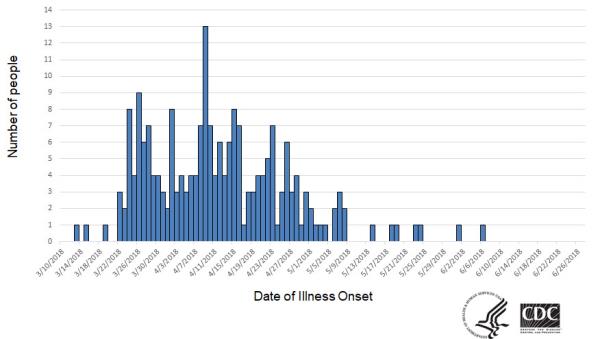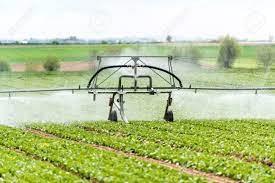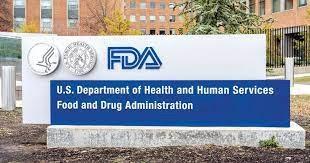During the past two years, FDA has flip-flopped on establishing rules to prevent contamination of leafy greens with irrigation water contaminated with ruminant-derived E. coli. Regular outbreaks of infection with STEC attributed to Romaine lettuce are documented by state public health agencies as collated by the CDC.

Annual STEC Outbreaks from Lettuce reported since 2018 |
The latest iteration of the so-called Green Produce Rule effectively places responsibility for assessing the degree of risk of contamination of irrigation and processing water back on to the producer. By eliminating microbial standards, the FDA has effectively granted a blank check to farmers to the detriment of consumers. Why has the FDA neglected epidemiologic realities and bowed to pressure exerted by farmer associations and lobbyists?
T he current situation contrasts with the July 2009 Final Rule on the Prevention of Salmonella in shell eggs there was virtually no consultation in establishing the Final Rule that incorporated specifics relating to biosecurity, flock testing and action in the event of a “positive”. The Final Rule also mandated regular inspection either as targeted or intensive audits. The latest version of the Final Rule on green produce contains recommendations relating to the source of water and requires risk assessments that are clearly beyond the capacity of individual farmers. The comment from the Executive Director of the Florida Organic Growers that “farmers will need some guidance, tools and even funding to comply with the rule” is a clearly an understatement. The FDA have maintained that they will assist in implementing whatever rule is finally issued.
he current situation contrasts with the July 2009 Final Rule on the Prevention of Salmonella in shell eggs there was virtually no consultation in establishing the Final Rule that incorporated specifics relating to biosecurity, flock testing and action in the event of a “positive”. The Final Rule also mandated regular inspection either as targeted or intensive audits. The latest version of the Final Rule on green produce contains recommendations relating to the source of water and requires risk assessments that are clearly beyond the capacity of individual farmers. The comment from the Executive Director of the Florida Organic Growers that “farmers will need some guidance, tools and even funding to comply with the rule” is a clearly an understatement. The FDA have maintained that they will assist in implementing whatever rule is finally issued.
If experience with the Final Rule on Salmonella in eggs is any indication, FDA auditors who had apparently received training had to be educated by farm production personnel and consultant veterinarians to function during 2011. If the FDA had not delegated the bulk of audits to authorized state departments of agriculture, implementation of the Rule would have never become reality.
EGG-NEWS has reported on outbreaks of STEC infection associated with Romaine lettuce since 2018. The source of the most recent outbreak involving patients in Michigan and Ohio has been traced to Romaine lettuce served on sandwiches by the Wendy’s chain in those states. The current outbreak is consistent with the experience of food-safety attorney Bill Marler who commented, “We continue to see what are basically regular intervals of outbreaks ties to leafy greens.” In June 2018, Wendy’s transitioned to sourcing tomatoes from greenhouses based on quality, absence of pesticides and the need to eliminate STEC contamination.
 The FDA clearly recognizes the source of infection as irrigation water contaminated by fecal material from ruminants. The Leafy Greens Association has attempted to minimize risk by establishing minimal distances between CAFOs and fields cultivating leafy greens. Essentially action taken by farmers’ associations in California and Arizona are self-serving and are intended to create a false sense of security and to placate regulatory agencies and consumer advocacy groups.
The FDA clearly recognizes the source of infection as irrigation water contaminated by fecal material from ruminants. The Leafy Greens Association has attempted to minimize risk by establishing minimal distances between CAFOs and fields cultivating leafy greens. Essentially action taken by farmers’ associations in California and Arizona are self-serving and are intended to create a false sense of security and to placate regulatory agencies and consumer advocacy groups.
The FDA should recognize the inevitability of contamination and work with academia and industry to develop a positive kill step in processing that will absolutely eliminate the probability of contamination with E. coli, Salmonella and Cryptosporidia. Perhaps they might exercise the same commitment that was demonstrated with Salmonella through the Final Rule introduced in 2019 after the problem of egg-borne salmonellosis was resolved by EQAPs developed by the industry.
Subscribers are encouraged to retrieve previous postings on foodborne pathogens from Romaine lettuce by entering “lettuce” in the SEARCH block.